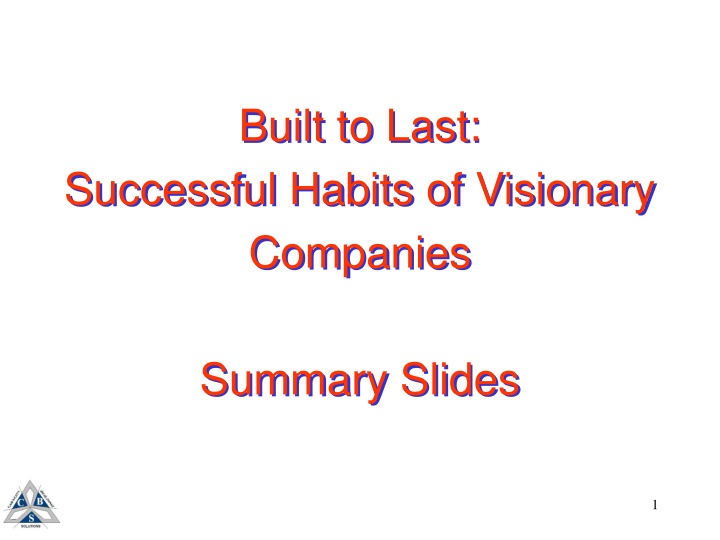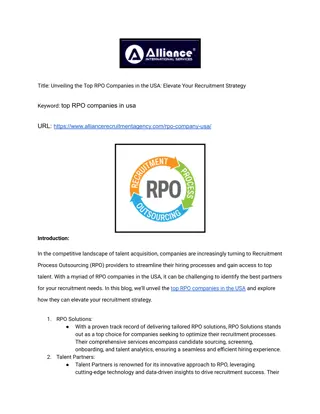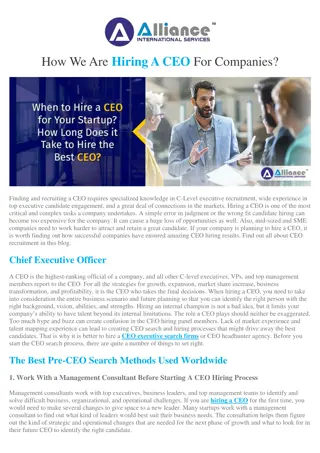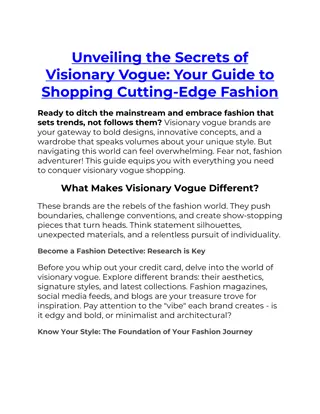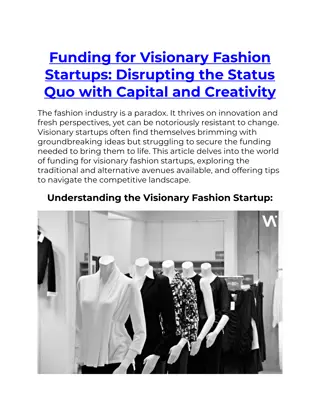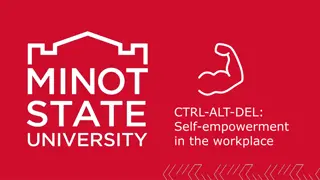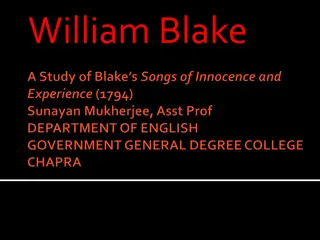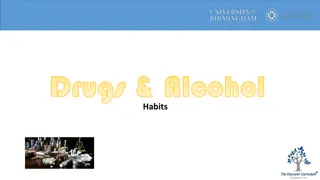Successful Habits of Visionary Companies Summary
Summary slides of "Built to Last: Successful Habits of Visionary Companies" by James C. Collins and Jerry I. Porras. The content covers key chapters, myths shattered, and insights on visionary companies. It emphasizes core values, BHAGs, company culture, leadership, and more. Explore the principles that set visionary companies apart and lead to long-term success.
Uploaded on Feb 25, 2025 | 0 Views
Download Presentation

Please find below an Image/Link to download the presentation.
The content on the website is provided AS IS for your information and personal use only. It may not be sold, licensed, or shared on other websites without obtaining consent from the author.If you encounter any issues during the download, it is possible that the publisher has removed the file from their server.
You are allowed to download the files provided on this website for personal or commercial use, subject to the condition that they are used lawfully. All files are the property of their respective owners.
The content on the website is provided AS IS for your information and personal use only. It may not be sold, licensed, or shared on other websites without obtaining consent from the author.
E N D
Presentation Transcript
Built to Last: Successful Habits of Visionary Companies Summary Slides 1
Built to Last Table of Contents Chapter 1 : The Best of the Best Chapter 7 : Try a Lot of Stuff and Keep What Works Chapter 8 : Home-Grown Management Chapter 2 : Clock Building, Not Time Telling Interlude : No Tyranny of the OR Chapter 3 : More Than Profits Chapter 4 : Preserve the Core/ Stimulate Progress Chapter 5 : Big Hairy Audacious Goals Chapter 6 : Cult-Like Cultures Chapter 9 : Good Enough Never Is Chapter 10 : The End of the Beginning Chapter 11 : Building the Vision Epilogue : Frequently Asked Questions 2 Source : Collins, James C. And Jerry I. Porras. Built to Last : Successful Habits of Visionary Companies.New York : HarperBusiness. 1994.
Built to Last Twelve Myths Shattered Reality Myth Few visionary companies began life with a great idea Visionary companies often get off to a slow start, but win the long race A charismatic leader sometimes is detrimental to a company s long-term prospects Effective leaders concentrate on architecturing an enduring institution instead of being a great individual leader Visionary companies pursue a cluster of objectives making money is only one of these objectives Visionary companies are guided by a core ideology core values and a sense of purpose beyond money There is no right set of core values for being a visionary company The important variable is how deeply a company believes its ideology and how consistently it expresses it in its actions 1. It takes a great idea to start a great company. 2. Visionary companies require great and charismatic visionary. 3. The most successful companies exist first and foremost to maximize profits. 4. Visionary companies share a common subset of correct core values. Source : Collins, James C. And Jerry I. Porras. Built to Last : Successful Habits of Visionary Companies.New York : HarperBusiness. 1994. 3
Built to Last Twelve Myths Shattered Reality Myth 5. The only constant is change. A visionary rarely, if ever, changes its core ideology However, visionary companies also strive for progress that enables them to change and adapt without compromising their core ideals 6. Blue-chip companies play it safe. Audacious Goals (BHAGs) Visionary companies have judiciously used BHAGs to stimulate progress and to outperform the competition 7. Visionary companies are great places to work for everyone. company a great place to work 8. Highly successful companies make their best moves by brilliant and complex strategic planning. Visionary companies are not afraid to commit to Big Hairy Only employees who fit extremely well with the core ideology and demanding standards will find the visionary Visionary companies make some of their best moves by experimentation, trial & error, opportunism, and by accident Let s just try a lot of stuff and keep what works Source : Collins, James C. And Jerry I. Porras. Built to Last : Successful Habits of Visionary Companies.New York : HarperBusiness. 1994. 4
Built to Last Twelve Myths Shattered Reality Myth Few visionary companies hire CEO s from the outside most companies promote from within Significant change and fresh ideas can come from the inside Visionary companies focus primarily on beating themselves How can we improve ourselves to do better tomorrow than we did today? Visionary companies do not subject themselves to the Tyranny of the OR Instead, they embrace the Genius of the AND Creating a statement can be a helpful step in building a visionary company, but to become one requires continual efforts to perform like one 9. Companies should hire outside CEOs to stimulate fundamental change. 10. The most successful companies focus primarily on beating the competition. 11. You can t have your cake and eat it too. 12. Companies become visionary primarily through vision statements . Source : Collins, James C. And Jerry I. Porras. Built to Last : Successful Habits of Visionary Companies.New York : HarperBusiness. 1994. 5
Built to Last Genius of the AND On the one hand : Purpose beyond profit A relatively fixed core ideology Conservatism around the core Clear vision and sense of direction Big Hairy Audacious Goals Selection of managers steeped in the core Ideological control Extremely tight culture (almost cult-like) Investment for the long-term Philosophical, visionary, futuristic Organization aligned with core ideology Yet, on the other hand : AND Pragmatic pursuit of profit AND Vigorous change and movement AND Bold, committing, risky moves AND Opportunistic groping and experimentation AND Incremental evolutionary progress AND Selection of managers that induce change AND Operational autonomy AND Ability to change, move, and adapt AND Demands for short-term performance AND Superb daily execution, nuts & bolts AND Organization adapted to its environment Source : Collins, James C. And Jerry I. Porras. Built to Last : Successful Habits of Visionary Companies.New York : HarperBusiness. 1994. 6
Built to Last Defining Core Ideology Core Values + Purpose Core Ideology = = The organization s essential and enduring tenets a small set of general guiding principles Not to be confused with specific cultural or operational practices Not to be compromised for financial gain or short-term expediency = The organization s fundamental reasons for existence beyond just making money a perpetual guiding star on the horizon Not to be confused with specific goals or business strategies Core Values Purpose Source : Collins, James C. And Jerry I. Porras. Built to Last : Successful Habits of Visionary Companies.New York : HarperBusiness. 1994. 7
Built to Last Instilling Core Ideology Steps to make an ideology pervasive throughout an organization : The visionary companies more thoroughly indoctrinate employees into a core ideology, creating cultures so strong they are almost cult-like. The visionary companies more carefully nurture and select senior management based on fit with core ideology. Visionary companies attain more consistent alignment with a core ideology in such aspects as goals, strategy, tactics, and organization design. 8 Source : Collins, James C. And Jerry I. Porras. Built to Last : Successful Habits of Visionary Companies.New York : HarperBusiness. 1994.
Built to Last Core Ideologies in Visionary Companies Core Ideology Company Ford People as the source of our strength Products as the end result of our efforts (we are about cars) Profits as a necessary means and measure for our success Basic honesty and integrity Improving the quality of life through technology and innovation Interdependent balance between responsibility to customers, employees, society, and shareholders (no clear hierarchy) The company exists to alleviate pain and disease We have a hierarchy of responsibilities : customers first, employees second, society at large third, and shareholders fourth Individual opportunity and reward based on merit Decentralization = Creativity = Production Give full consideration to the individual employee Spend a lot of time making customers happy Go the last mile to do things right; seek superiority in all we undertake General Electric Johnson & Johnson IBM 9 Source : Collins, James C. And Jerry I. Porras. Built to Last : Successful Habits of Visionary Companies.New York : HarperBusiness. 1994.
Built to Last Core Ideologies in Visionary Companies Core Ideology Company Philip Morris The right to personal freedom of choice (to smoke, to buy whatever one wants) is worth defending Winning being the best and beating others Encouraging individual initiative Opportunity to achieve based on merit, not gender, race, or class Hard work and continuous self-improvement To experience the sheer joy that comes from the advancement, application, and innovation of technology that benefits the general public To elevate the Japanese culture and national status Being a pioneer not following others, but doing the impossible Respecting and encouraging each individual s ability and creativity No cynicism allowed Fanatical attention to consistency and detail Continuous progress via creativity, dreams, and imagination Fanatical control and preservation of Disney s magic image To bring happiness to millions and to celebrate, nurture, and promulgate wholesome American values Sony Walt Disney 10 Source : Collins, James C. And Jerry I. Porras. Built to Last : Successful Habits of Visionary Companies.New York : HarperBusiness. 1994.
Built to Last Preserve the Core / Stimulate Progress Five Methods that visionary companies use to preserve the core while stimulating progress : Big Hairy Audacious Goals (BHAGs) Cult-Like Cultures Commitment to challenging, audacious, and risky goals Great places to work only for those who buy-in to the core ideology. High levels of action and experimentation that produce new and unexpected paths. Promotion from within bringing to senior levels only those who have been steeped in the core ideology. A continual process of relentless self-improvement with an aim of doing better forever. Stimulates progress Preserves the core Stimulates progress Try a Lot of Stuff and Keep What Works Home Grown Management Preserves the core Good Enough Never Is Stimulates progress Preserve the Core Stimulate Progress 11 Source : Collins, James C. And Jerry I. Porras. Built to Last : Successful Habits of Visionary Companies.New York : HarperBusiness. 1994.
Built to Last Preserve the Core / Stimulate Progress An interplay exists between core ideology and the drive for progess : Core Ideology Provides continuity and stability. Drive for Progress Urges continual change (new directions, new methods, new strategies etc.). Impels constant movement (toward goals, improvement, envisioned form etc.). Expands the number and variety of possibilities that the company can consider. Can be content-free ( Any progress is good, as long as it is consistent with our core ). Expressing the drive for progress can lead to dramatic, radical, and revolutionary change. Plants a relatively fixed stake in the ground. Limits possibilities and directions for the company (to those consistent with ideology). Has clear content ( This is our core ideology and we will not breach it ). Installing a core ideology is a conservative act. Preserve the Core Stimulate Progress 12 Source : Collins, James C. And Jerry I. Porras. Built to Last : Successful Habits of Visionary Companies.New York : HarperBusiness. 1994.
Built to Last Big Hairy Audacious Goals - BHAGs Definition : A BHAG should be so clear and compelling that it requires little or no explanation. A BHAG is a goal, not a statement. A BHAG should fall well outside the comfort zone. People in the organization should believe they can pull it off, but it should require heroic efforts and perhaps a little luck. A BHAG should be so bold and exciting in its own right that it would continue to stimulate progress even if the organization s leaders disappear before it is completed. An organization should prepare to prevent the we ve arrived syndrome after completing a BHAG often by having complementary follow-on BHAGs. Most importantly, a BHAG should be consistent with the organization s core ideology. Preserve the Core Stimulate Progress 13 Source : Collins, James C. And Jerry I. Porras. Built to Last : Successful Habits of Visionary Companies.New York : HarperBusiness. 1994.
Built to Last Examples of BHAGs Stimulating Companies Core to Preserve BHAGs to Stimulate Preserve the Core Stimulate Progress Seek superiority in all we undertake; Spend a lot of time making customers happy We are about cars especially care for the average person Winning being the best and beating others; Personal freedom of choice is worth defending Commit to a $5 billion gamble on the 360; Meet the emerging needs of our customer (IBM) Democratize the automobile (Ford) Slay Goliath and become the front-runner in the tobacco industry, despite the social forces against smoking Build Disneyland and build it to our image, not industry standards (Philip Morris) (Disney) Bring happiness to millions ; fanatical attention to detail; creativity, dreams, imagination Elevation of the Japanese culture and national status; Being a pioneer, doing the impossible Change the worldwide image of Japanese products as poor quality; Create a pocketable transistor radio (Sony) Source : Collins, James C. And Jerry I. Porras. Built to Last : Successful Habits of Visionary Companies.New York : HarperBusiness. 1994. 14
